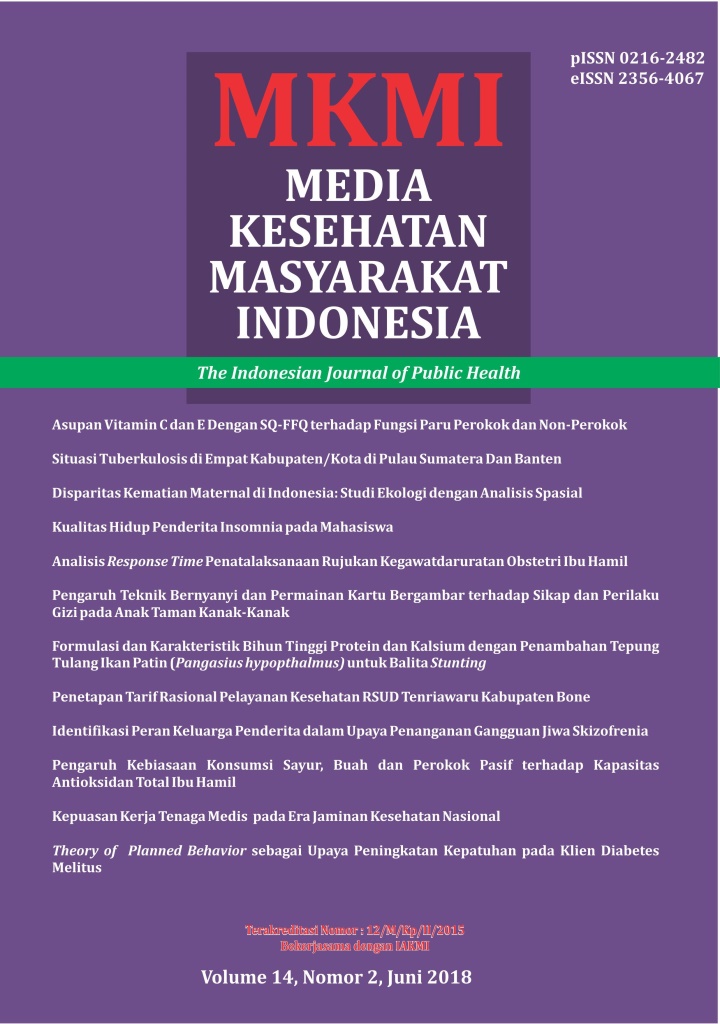Formulasi dan Karakteristik Bihun Tinggi Protein dan Kalsium dengan Penambahan Tepung Tulang Ikan Patin (Pangasius Hypopthalmus) Untuk Balita Stunting
Abstract
Stunting is the nutritional problems in Indonesia. The direct cause of stunting was infectious disease andinadequate food intake such as protein and calcium deficiency. Patin fishbone powder contain high in protein, calciumand phosphor needed for growth children under five years. Utilization of patin fishbone powder is processedinto flour and made rice noodle for children under five years stunting. The aims of the research were to determinethe best formula and characteristics of rice noodles high protein and calcium with addition of patin fishbone powder(Pangasius hypopthalmus) for children under five years stunting. A complete randomized design was used forthe experiment. Variables analyzed were : chemical properties (water content, total fat, total protein, carbohydrateby difference and ash content), calcium and phosphor, and sensory properties (hedonic test and hedonic quality).Hedonic test was conducted to determine the level of consumer acceptance of 25 semi-trained panelists. Data wereanalyzed by ANOVA. The results showed rice n noodles with addition of patin fishbone powder (HypopthalmusPangasius) water content 6.79%, ash 64.23%, protein content 20.39%, fat content 3.36%, carbohydrate 8.35%,calsium 1002.00 mg/100g and fosfor 12.80 mg/100g. Based on ANOVA test there is the effect of addition of patinfishbone flour to taste (p=0,001) and smell (p=0,041) , while color (p=0.116) and texture (p=0,102) have no effect.The best formula was rice noodles from F1 (4%) for children under five years stunting.
References
1. Astawan M.2009. Panduan Karbohidrat Terlengkap. Jakarta (ID): Dian Rakyat
2. Dinas Perikanan dan Kelautan Provinsi Riau.2013. Buku Tahunan Statistik Perikanan Provinsi Riau. Pekanbaru.
3. Yantos.2016. Kajian Pemerintah Kabupaten Kampar terhadap Peningkatan Daya Saing UKMK Desa Koto Mesjid dalam Menghadapi Masyarakat Ekonomi ASEAN (MEA). Jurnal RISALAH. 27 (1):32-4.
4. Kaya A O W .2008. Pemanfaatan Tepung Tulang Ikan Patin (Pangasius SP) sebagai Sumber Kalsium dan Fosfor dalam Pembuatan Biskuit [Skripsi]. Bogor (ID): Institut Pertanian Bogor.
5. Winarno FG.2008. Kimia Pangan dan Gizi. Jakarta (ID): PT Gramedia Pustaka.
6. Lestari S.2001. Pemanfaatan Tulang Ikan Tuna (Limbah) untuk Pembuatan Tepung Tulang. [Skripsi]. Bogor (ID): Institut Pertanian Bogor
7. Santoso J, Gunji S, Yoshie SY, Suzuky T. 2012. Mineral Content of Indonesian seaweeds and mineral solubilityaffecsted by basic cooking. Food Sci.Tech. Res 12:59-66.
8. Mulia.2004. Kajian Potensi Limbah Tulang Ikan Patin (Pangasius SP) sebagai Alternatif Sumber Kalsium dalam Produk Mi Kering [Skripsi]. Bogor (ID): Institut Pertanian Bogor.
9. Tabaka R .2004. Pemanfaatan Tepung Tulang Ikan Patin (Pangasius SP) dalam Pembuatan Mi Kering [Skripsi]. Bogor (ID): Institut Pertanian Bogor.
10. Syah D .2012. Pengantar Teknologi Pangan. Bogor (ID): IPB Press.
11. Setyaningsih D, Aprianto A, Sari MP .2010. Analisis Sensori untuk Industri Pangan dan Argo. Bogor (ID): IPB Press.
12. Kemenkes RI. Hasil Riset Kesehatan Dasar 2013. Jakarta: Badan Penelitian dan Pengembangan Kesehatan; 2013
Read More
2. Dinas Perikanan dan Kelautan Provinsi Riau.2013. Buku Tahunan Statistik Perikanan Provinsi Riau. Pekanbaru.
3. Yantos.2016. Kajian Pemerintah Kabupaten Kampar terhadap Peningkatan Daya Saing UKMK Desa Koto Mesjid dalam Menghadapi Masyarakat Ekonomi ASEAN (MEA). Jurnal RISALAH. 27 (1):32-4.
4. Kaya A O W .2008. Pemanfaatan Tepung Tulang Ikan Patin (Pangasius SP) sebagai Sumber Kalsium dan Fosfor dalam Pembuatan Biskuit [Skripsi]. Bogor (ID): Institut Pertanian Bogor.
5. Winarno FG.2008. Kimia Pangan dan Gizi. Jakarta (ID): PT Gramedia Pustaka.
6. Lestari S.2001. Pemanfaatan Tulang Ikan Tuna (Limbah) untuk Pembuatan Tepung Tulang. [Skripsi]. Bogor (ID): Institut Pertanian Bogor
7. Santoso J, Gunji S, Yoshie SY, Suzuky T. 2012. Mineral Content of Indonesian seaweeds and mineral solubilityaffecsted by basic cooking. Food Sci.Tech. Res 12:59-66.
8. Mulia.2004. Kajian Potensi Limbah Tulang Ikan Patin (Pangasius SP) sebagai Alternatif Sumber Kalsium dalam Produk Mi Kering [Skripsi]. Bogor (ID): Institut Pertanian Bogor.
9. Tabaka R .2004. Pemanfaatan Tepung Tulang Ikan Patin (Pangasius SP) dalam Pembuatan Mi Kering [Skripsi]. Bogor (ID): Institut Pertanian Bogor.
10. Syah D .2012. Pengantar Teknologi Pangan. Bogor (ID): IPB Press.
11. Setyaningsih D, Aprianto A, Sari MP .2010. Analisis Sensori untuk Industri Pangan dan Argo. Bogor (ID): IPB Press.
12. Kemenkes RI. Hasil Riset Kesehatan Dasar 2013. Jakarta: Badan Penelitian dan Pengembangan Kesehatan; 2013
Authors
Afrinis, N., Besti, V., & Anggraini, H. D. (2018). Formulasi dan Karakteristik Bihun Tinggi Protein dan Kalsium dengan Penambahan Tepung Tulang Ikan Patin (Pangasius Hypopthalmus) Untuk Balita Stunting. Media Kesehatan Masyarakat Indonesia, 14(2), 157-164. https://doi.org/10.30597/mkmi.v14i2.3984

This work is licensed under a Creative Commons Attribution-NonCommercial-ShareAlike 4.0 International License.

